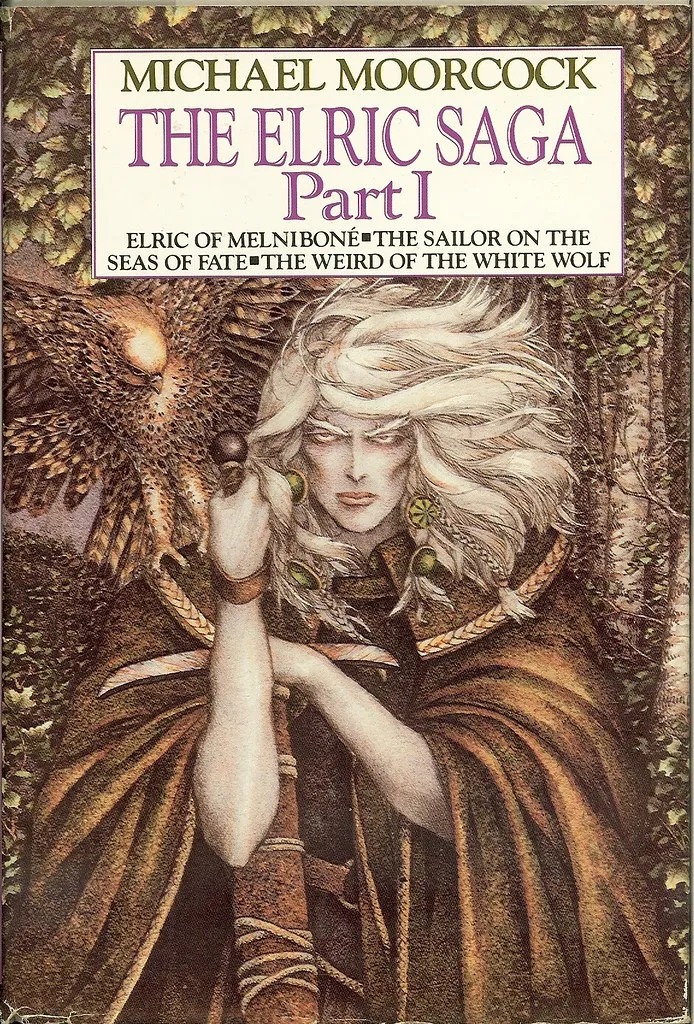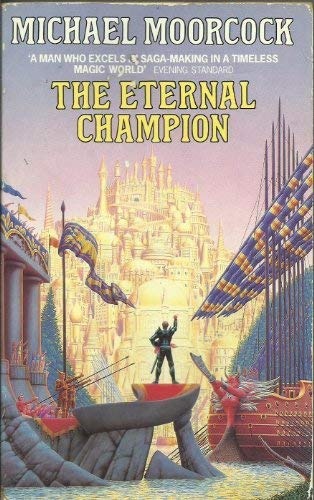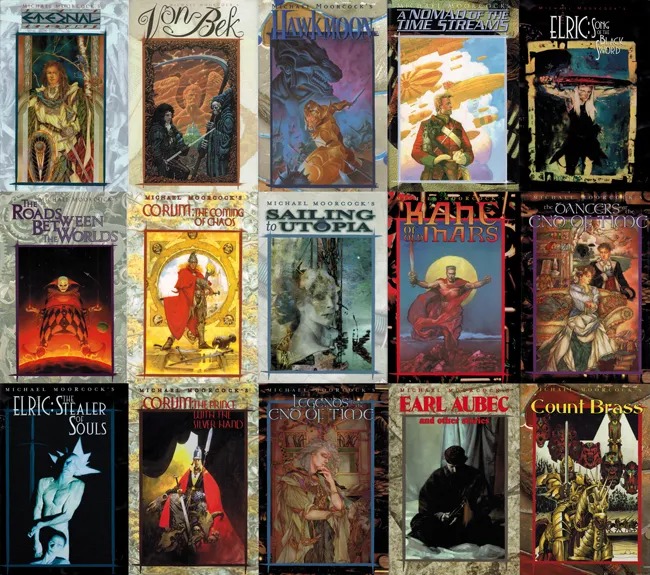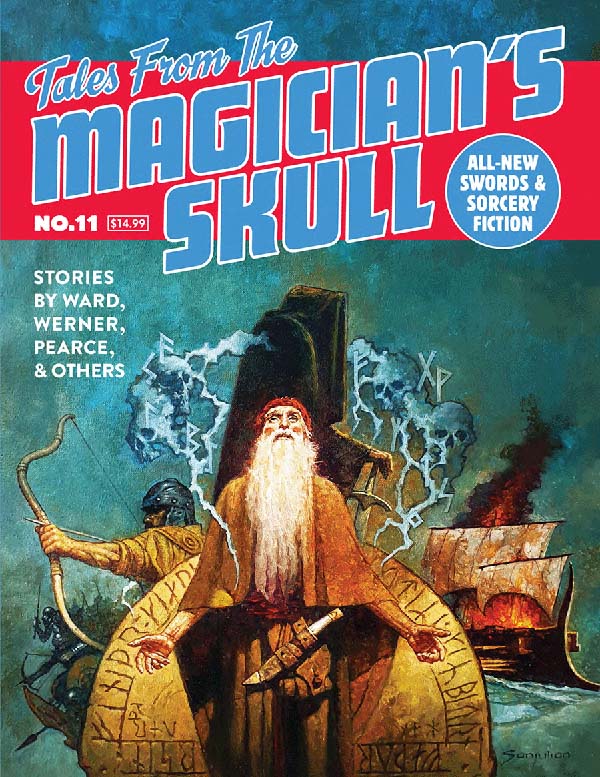Be sure to join Goodman Games and Sanctum Secorum for a live Twitch interview with the legendary Michael Moorcock this Saturday, October 8th!
Where to Start with Michael Moorcock’s Eternal Champion
by Bill Ward
One of the barriers to entry to the works of varied and prolific British author Michael Moorock is the interconnectedness of much of his work. It isn’t simply that Moorcock’s six decade (and counting!) career has seen him writing everything from pure pulp sword-and-sorcery, New Wave science fiction, alternative history, space opera, genre satire, contemporary litfic . . . and, on occasion, ‘all of the above,’ it’s that Moorcock has also playfully created a kind of uber-narrative spanning his entire output as a writer. Moorcock has always kept moving his own goal posts, repeatedly striking out into new territory while maintaining a connection with the kinds of stories for which he is best known – but some of lore surrounding his later work, work that sees him heavily invested in stringing threads between series and characters in a recursive web of characters and cross-references, can perhaps frustrate a newcomer’s desire just to read and enjoy his fun adventure stories, such as those tales of his justly famous Eternal Champion.
It is these stories, specifically the core works of Elric, Corum, Hawkmoon, and Erekosë, that are likely to be of most interest to fans of Tales From the Magician’s Skull – and these works also just happen to be some of the best entry points into Moorcock’s long, and at times complicated, body of work. Most of these stories were written early in his career or had their genesis in his fast-paced, pulpier style of writing, and thus they are unabashedly and unapologetically fantasy adventure tales written with speed, color, and imagination. Many of the threads that sometimes connect these tales tend to be mostly thematic, or even rather straight-forward and playful character-hopping cameos (all of the four aforementioned Eternal Champions appear in one another’s respective series), or else don’t really arise until later works (such as Elric’s The Moonbeam Roads trilogy).
Something that sets Moorcock’s sword-and-sorcery apart from the work of many contemporaries who were also in just as much of a hurry to make a sale, is that they engage the imagination on multiple levels. He gives you lost cities, odd characters, fantastical monsters, and artifacts of surprising power, but he also keeps the very nature of the story surprising by skewing things into unexpected directions and introducing intriguing ideas and concepts – characters in a Moorcock sword-and-sorcery story are more likely to travel to another dimension than to another town, face a cataclysm of gods and empires, or even meet themselves in another incarnation! This at once mythically huge-scale epic quality transposed onto the freeform and snapfire quick pacing and invention of race-ahead pulp action is a heady and unique combination that early on marked Moorcock as a distinctive voice in sword-and-sorcery.
And one such high-level conceit is the notion of the Champion Eternal – the immortal essence of a great warrior who incarnates again and again in all ages, all planes of existence, and is forever destined to take place in the cosmic war between Law and Chaos. This is one of the biggest connecting threads in the work of Moorcock – and it is also clearly a meta-fictional wink to the perpetually recurrent nature of pulp adventure writing itself. On some level, to write of endless rollicking quests and wars and journeys and battles is to be re-living the same story beats, the same character, over and over again. But Moorcock keeps even his most plot-driven narratives engaging with novel ideas, emotional weight, and vibrantly imaginative scenes – in his hands, even the McGuffin-quests and deus ex machina plot twits that characterize some of these early tales not only work, but actually serve to elevate the stories, especially in concert with the other thematic elements Moorcock plays with across his multiverse. He is a writer who tells of weighty dooms with a twinkle in his eye, and if you can faintly detect the typewriter pounding behind every sudden reversal, exposition-delivering minor character, third-act shift, or unexpected intervention by a god, you’ll quickly realize that what you are really hearing is the rhythm of pure story, the heartbeat of adventure.
So Where to Start? As demonstrated by the curious incident of Agak and Gagak, it is fatally dangerous to the fabric of the universe itself to gather more than four of the Champions Eternal into one location; therefore I summon the Last Emperor of Melniboné Elric Kinslayer, Prince of the Scarlet Robe and Silver Hand Corum Jhaelen Irsei, bane of the Dark Empire Duke Dorian Hawkmoon von Köln, and Dead Erekosë, the only incarnation of the Eternal Champion doomed to remember his many lives as the 20th century man John Daker.
Starting with any of these series characters is an excellent way to sample some of Michael Moorcock’s early sword-and-sorcery. All of them have their multi-volume series condensed into omnibus reprints, which makes them even easier to obtain. Of the four, Erekosë (The Eternal Champion) is perhaps the least reprinted and Elric, by dint of his tremendous popularity and somewhat (appropriately) chaotic publication history is both the most reprinted, and perhaps the most confusing to collect – and because of this I will save discussion of the Elric series until I’ve spotlighted the other three.
Both the Corum and Hawkmoon series are not only some of the most straightforward Moorcock sword-and-sorcery to collect and read, but they represent his most accessible work as a fantasy adventure novelist. They have the same colorful, pulp exuberance and invention of his magazine fiction (such as most of the early Elric tales), but they are presented as much more structurally coherent short three-act novels.
The Swords Trilogy (alternately The First Chronicles of Corum) consists of The Knight of the Swords, The Queen of the Swords, and The King of the Swords, and introduces Corum Jhaelen Irsei, maimed scion of a lost people, bearer of the dread Eye of Rhynn and Hand of Kwll, and slayer of the Lords of Chaos. Combining a hugely epic scope and mythic resonance with fast-paced adventure, these stories capture some of the plane-hopping high magic weirdness of the Elric stories, but with a less angst-infused doom. The follow up trilogy, The Prince With the Silver Hand (or The Silver Hand Trilogy, or The Second Chronicles of Corum) is comprised of The Bull and the Spear, The Oak and the Ram, and The Sword and the Stallion. In these, Corum is summoned to another time and place to defeat the diseased extra-planar ice-bringers, the Fhoi Myore, intent on freezing the world of men in a final desolation. The slight hints of Celtic mythology found in the first Corum trilogy are on full blast in the second, and the entire sequence reads like an electric rock opera cover of an Irish folksong of gods and heroes and battles long ago.
Hawkmoon’s saga is also divided into two series, The History of the Runestaff (The Jewel in the Skull, The Mad God’s Amulet, The Sword of the Dawn, and The Runestaff) and The Chronicles of Castle Brass (Count Brass, The Champion of Garathorm, and The Quest for Tanelorn). The first of these introduces the Dark Empire of Granbretan, a mirror-universe far-future Great Britain that has conquered all of Europe with ancient science and beast-mask wearing legions, ruled by a two-millennia old feeble emperor in a life-support throne. Hawkmoon is the champion who stands against the empire – though he is also forced to serve it by the implantation of a black jewel in his forehead – and over four books his quest for the Runestaff, powerful reality-defining artifact that can bring down Granbretan, takes him to many strange lands. The History of the Runestaff is one of the absolute best places to start with Moorcock, especially for modern readers of fantasy more in-tune with series fiction than short stories and novellas. The follow-up series, Castle Brass, is much more inter-connected with Moorcock’s multiverse of stories, for example by tying in directly with the the tales of Erekosë, and lacks the compelling grand villain of the first – though its final volume does actually tell of the very last conflict of the Eternal Champion, and is the last book in the ‘uber-series.’
While, the ‘Eternal Champion’ is the collective term for all of these tales of heroes (and anti-heroes), The Eternal Champion series proper concerns Erekosë – or John Daker, as he is introduced to us, a 20th century man haunted by strange memories of his many other lives as the champion forever battling the extreme poles of Law and Chaos in service of the Eternal Balance. The first tales of Erekosë were some of the earliest fiction Moorcock wrote as a teen, and were subsequently expanded upon into the editions in-print today – and, of course, conceptually into some of the underlying framework of his entire body of writing.
Written in first person, the early Erekosë stories in The Eternal Champion and Phoenix in Obsidian establish an interesting difference between Erekosë and other incarnations of the Champion – not only can he remember his other selves, but his spirit is summoned from our own time to inhabit his heroic alter egos in strange times and places. This series, especially the later-written third book The Dragon in the Sword with its tie in to the Von Bek books, establish not only key concepts and themes that would go on to infuse all of Moorcock’s writing, but begins to connect those worlds in a more meaningful way. It’s initial offerings, however, are not as polished as some of Moorcock’s later work.
Of course, Moorcock, like Robert E. Howard before him, has become almost synonymous with his most famous creation. Elric of Melniboné , White Wolf and Soul-Thief, albino Prince of Ruins, Sad Poet mantled in doom and bearing a black vampiric hellblade, is without doubt Moorcock’s most iconic and popular character. Overwhelmingly this is where most newcomers wish to start and, somewhat paradoxically despite the wildly out-of-order nature of his saga, the multiple title and edition changes, and the absolute ton of reprints across various publishers, it is actually one of the easiest series to get into. With one big exception (The Moonbeam Roads trilogy), a beginner can pick up any Elric book and just read.
This is because much of Elric was born in magazine fiction, many of his stories are standalone tales that just lightly reference other events – and certainly not to the degree that a reader is dependent on the information. And Moorcock’s writing of Elric’s saga outside of any kind of chronology means that some of the earliest tales he wrote in the 60s see not only the death of the character, but the complete destruction of his world. Such stories are collected in what is now considered the sixth book in the series, Stormbringer – and at the time of this writing the twelfth Elric novel is due to be released in a few months (The Citadel of Forgotten Myths).
What this amounts to is a real freedom in how you approach Elric – which is a bit like how Moorcock himself approached the series. It makes perfect sense to grab the various omnibus versions out there (the old scifi bookclub editions, Millennium or White Wolf’s Eternal Champion series, Del Rey’s reprints, Gollancz in the UK, or the most recent offerings from Saga Press, to name just a few of the more prevalent), but it’s also perfectly fine to just grab that random DAW or Ace paperback you picked up at a used bookstore and dive right in.
The core six books in the Elric series are arranged chronologically in the following order: Elric of Melniboné, The Sailor on the Seas of Fate, The Weird of the White Wolf, The Vanishing Tower (aka The Sleeping Sorceress in the UK), The Bane of the Black Sword, and Stormbinger. Elric of Melniboné nicelyserves to introduce Elric’s backstory, and to depict his time as Emperor with some effective foreshadowing of the dark path that awaits him – which makes perfect sense when you consider it was actually written after most of the other stories that comprise this initial run of Elric! Stormbringer, the great culmination of Elric’s entire epic, consists of stories that were written fairly early on – and while one might be tempted to save reading ‘the end’ of the series until experiencing the five (soon to be six) subsequent Elric volumes, my opinion is that it rather firmly belongs to this early story sequence – not only does Moorcock’s style and manner of storytelling shift somewhat in future books, but the events of Stormbringer are built upon in subsequent volumes, even though they technically ‘come first.’
The Fortress of the Pearl and The Revenge of the Rose are two Elric books released after the initial six, and both can be slotted chronologically into the sequence above (Fortress after Elric of Melniboné, Revenge after The Vanishing Tower/The Sleeping Sorceress), or simply read in publication order. Like the forthcoming The Citadel of Forgotten Myths, thesebooks take place in Elric’s wandering days, and offer further standalone adventures – both also reflect a bit of a stylistic and thematic shift away from the early sword-and-sorcery pulp-style Elric tales, and also introduce more of the interconnected elements of Moorcock’s multiverse. However, if all of this seems a bit overwhelming it’s worth reiterating that it doesn’t really matter where you start or in what order you read any of these books, so long as you have at least a vague awareness of where they fall in the sequence.
Now, where it does matter in regards to the Elric saga is that ‘one big exception’ I mentioned earlier, and that is the three books of The Moonbeam Roads trilogy: The Dreamthief’s Daughter, The Skrayling Tree, and The White Wolf’s Son (Daughter of Dreams, Destiny’s Brother, and Son of the Wolf in the UK).This would be books nine, ten, and eleven in the Elric chronology, but I suppose they’d also have to be slotted somewhere into the Von Bek sequence … yes, it’s starting to get a little complicated. In this series Elric, lashed to the mast of Jagreen Lern’s flagship in Stormbringer, has entered into a thousand-year dream quest to find his sword, projecting himself into various times and places – and even people.
The books in this trilogy are thoroughly interconnected with Moorcock’s larger multiverse of stories, and I’d strongly recommend reading at least some of those other books first to get the most enjoyment of The Moonbeam Roads, which draws on everything from the really excellent Von Bek tales (The War Hound and the World’s Pain and The City in the Autumn Stars), to the alternate history steampunk of Oswald Bastable in The Nomad of the Time Streams (The Warlord of the Air, The Land Leviathan, and The Steel Tsar), and even further connections to the Cornelius and Pyat Quartets, as well as one major character also found in the Corum tales and a skewed version of the setting of The History of the Runestaff – just about everything and everyone (including Moorcock himself!) makes an appearance in this grand work of time- and universe-jumping synthesis, and for that reason it is definitely not the place to start, but rather one with which to finish.
These core works are the foundation upon which all the other varied and inventive works of Moorcock’s lifetime of writing are based, and as such they don’t just serve as entertaining introductions to his Eternal Champion books, but to his writing itself.














